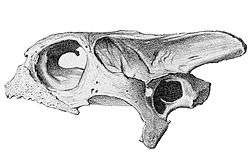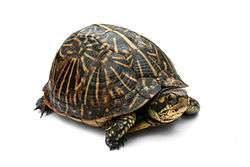Domed Mauritius giant tortoise
| Domed Mauritius giant tortoise | |
|---|---|
 | |
| Skull of Cylindraspis triserrata | |
| Scientific classification | |
| Kingdom: | Animalia |
| Phylum: | Chordata |
| Class: | Reptilia |
| Order: | Testudines |
| Family: | Testudinidae |
| Genus: | Cylindraspis |
| Species: | C. triserrata |
| Binomial name | |
| Cylindraspis triserrata Günther, 1873 | |
| Synonyms[1] | |
| |
The domed Mauritius giant tortoise (Cylindraspis triserrata) is an extinct species of tortoise. It was endemic to Mauritius.
Description
One of two different giant tortoise species which were endemic to Mauritius, this domed species seems to have specialised in grazing of grass, as well as fallen leaves and fruit on forest floors. Its sister species was likely a browser of higher branches, and although similarly sized, the two species differed substantially in their body shape and bone structure. The domed species had a flatter, rounder shape, with thinner bones and shell. The species name triserrata actually refers to the three bony ridges on this animal's mandibles - possibly a specialisation for its diet.
Extinction

This species was previously numerous throughout Mauritius - both on the main island and on all the surrounding islets. As Mauritius was the first of the Mascarene islands to be settled, it was also the first to face the extermination of its biodiversity - including the tortoises. The tortoise species, like many island species, were reportedly friendly, curious and not afraid of humans.
With the arrival of the Dutch, vast numbers of both tortoise species were slaughtered - either for food (for humans or pigs) or to be burned for fat and oil. In addition, they introduced invasive alien species such as rats, cats and pigs, which ate the tortoises eggs and hatchlings.
The species was likely extinct on the main island of Mauritius by about 1700, and on most of the surrounding islets by 1735.
Round island refuge
The 1846 Lloyd report suggests that at least one of the two Mauritian tortoise species might have survived on Round Island (just north of Mauritius) until much later.
The Lloyd expedition in 1844 found several giant tortoises surviving on Round island, and Mr Corby, one of the explorers, "captured a female land tortoise in one of the caves on Round Island and brought it to Mauritius, where it produced numerous progeny, which distributed among his acquaintance."
While hypothetically a 1845 hatchling could easily have lived into the twenty first century, it is not known what happened to the hatchlings, and Round island itself had goats and rabbits introduced to it soon afterwards. This led to the total extinction of the tortoises in their last refuge, and at the unknown point when the last of Mr Corby's hatchlings died or was killed, the species would have become totally extinct.[2][3][4]
See also
 Turtles portal
Turtles portal
References
- ↑ Fritz Uwe; Peter Havaš (2007). "Checklist of Chelonians of the World". Vertebrate Zoology. 57 (2): 278. ISSN 1864-5755. Archived from the original (PDF) on 2010-12-17. Retrieved 29 May 2012.
- ↑ A.Cheke, J.P.Hume: Lost Land of the Dodo: The Ecological History of Mauritius, Réunion and Rodrigues. Bloomsbury Publishing. 2010. p.211.
- ↑ Cheke AS, Bour R: Unequal struggle—how humans displaced the tortoise's dominant place in island ecosystems. In: Gerlach J, ed. Western Indian Ocean Tortoises: biodiversity. 2014.
- ↑ http://aobpla.oxfordjournals.org/content/7/plv085.full
- World Conservation Monitoring Centre 1996. Cylindraspis triserrata. 2006 IUCN Red List of Threatened Species. Downloaded on 29 July 2007.

